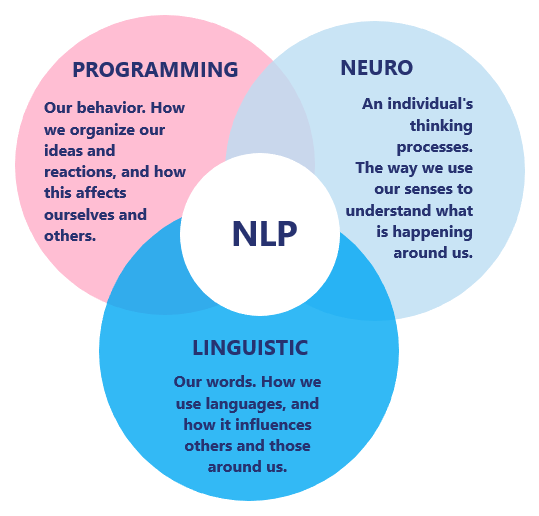Neuro-Linguistic Programming (NLP) studies human communication processes and outlines various methods and models that enable the conscious and targeted use of communication.
The founders of NLP, mathematician and psychologist Richard Bandler and linguist John Grinder, began analyzing and systematizing the behavioral patterns of successful therapists, such as Virginia Satir, Fritz Perls, and Milton H. Erickson, in the early 1970s. They focused on the language patterns used by these therapists and their exceptional ability to effect change in individuals through communication (Maron, 1979). Their core assumption was that humans perceive, process, and map their environment not only with their senses, but through their entire neurology—comprising the senses, nerves, and brain—into “internal maps” based on language. It is these linguistic patterns and structures that can be communicated, altered, and influenced.
The goal of NLP is to leverage these connections to change both internal processes and the habitual behaviors that follow, in desired directions. Based on their research, Bandler and Grinder (1975a, 1975b), Grinder and Bandler (1976), and Grinder, DeLozier, and Bandler (1977) developed hypotheses about how change occurs in people and how it can be specifically induced through particular methods of nonverbal and verbal communication—such as targeted language use or decision-making training.
According to Ludwig and Menendez (1985), NLP is applied across various fields where communication plays a key role, such as education, psychotherapy, sales, management, administration, and coaching. NLP seminars cover a wide range of topics, including conflict analysis, conflict resolution strategies, overcoming blockages, facilitation techniques, thinking strategies, decision-making, personality analysis, communication training, and behavior-influencing techniques based on NLP. The primary aim is to foster individual self-awareness, particularly how to adapt to others or take the lead (→ leadership) in interactions.
The advantages of NLP for organizations include improving internal communication, boosting work motivation (→ motivation), enhancing learning success, aligning with the company’s vision (→ vision), and reducing fear of change. NLP also aims to improve confidence when interacting with customers and business partners by teaching employees to closely observe and interpret nonverbal cues, thus fostering effective and creative communication.
NLP faces criticism primarily from academics. Although it incorporates elements of recognized theories, it is seen as imprecise, lacking a clear theoretical framework, combining heuristic methods, and in some cases, blending with esoteric teachings. The effectiveness of NLP remains unproven, as empirical studies often fail to meet the minimum requirements for proving efficacy. NLP training programs are regulated differently across countries, with some warnings about unqualified practitioners. As a result, NLP associations have established ethical guidelines and qualification criteria to ensure transparency regarding the credentials of trainers.
« Back to Glossary Index





![15 Employee Offboarding Templates That Save Hours of HR Time [Free Downloads] 15 Employee Offboarding Templates That Save Hours of HR Time [Free Downloads]](https://i1.wp.com/www.hrcloud.com/hubfs/Header.png?w=150&resize=150,100&ssl=1)
